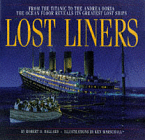
In the 1980s Dr. Robert Ballard was determined to discover the Titanic. On several occasions he tried to rally an expedition to find the most famous shipwreck of all time. To him undersea exploration was easy but the Titanic, deep on the Atlantic sea bed would push boundaries further than any deep sea diver had previously gone.
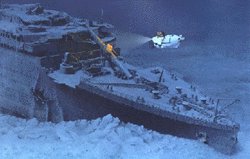
Equipment had to be specially designed to withstand the water pressures of the depths they needed to explore. The Titanic would lay at a depth over 13,000 feet.
In 1973, the submersible Alvin went through design changes. Inparticular, her steel hull was replaced with titanium alloy which could better withstand the depths involved.
Eventually funding was granted from Woods Hole and equipment was borrowed from various sources that included a side scan sonar, a deep-towed magnetometer, an LIBEC imaging system and of course underwater cameras.
The Titanic's distress signal placed the Titanic at 41°46'N, 50° 14' west. Part of the British Enquiry was to ascertain if this was exact. It concluded that the position given was slightly inaccurate as the Carpathia, who raced to the Titanic's rescue, reached the lifeboats before they should have done if the position was accurate.
Ballard's search strategy was simply: they would scan the ocean floor within a best search triangle until they found the ship.
Earlier in 1981 Jack Grimm led a team to find the ship, positive that they were searching the exact spot the ship foundered - they had not. Revised calculations suggested that the Titanic was eight miles further north than previously thought. They allowed for the speed of the lifeboats and the probable drift Titanic would have had on her way both after she had stopped and then down to the bottom of the ocean.
After reworking these calculations, a second 1981 expedition failed again. The Deep-tow passed within a mile and a half of the wreck but the sonar scanners were out of range. After three weeks of searching Grimm was convinced he had found one of Titanic's propellers. He began to tell the world that Titanic had been found.
Two years later Grimm wanted to search the area again but the expedition failed. Ballard who had followed the expeditions with great interest realised that Grimm had not spent enough time looking for the ship. It was now Ballard's turn.
Ballard had a realisation which led him to develop the Argo/Jason concept. When assembled they were a remote controlled deep towed deep sea video vessel combined with a swimming robot on a cable leash. The name of the project was derived form Greek mythology (Jason and the Argonauts).
Argo would be an unmanned submarine loaded with video cameras towed above the ocean bottom at the end of fibre-optical wires. The built in sonar could scan accurately the ocean floor for small debris.
In 1984 the US Navy agreed to fund a three week test for the following summer and Argo was built.
Aboard the Knorr, Ballard sailed to where he believed the Titanic sank. He hoped that his French colleagues had not beaten him to the wreck. However, by the end three weeks he had not found the ship and on August 6 1985 headed home.
Lateral thinking
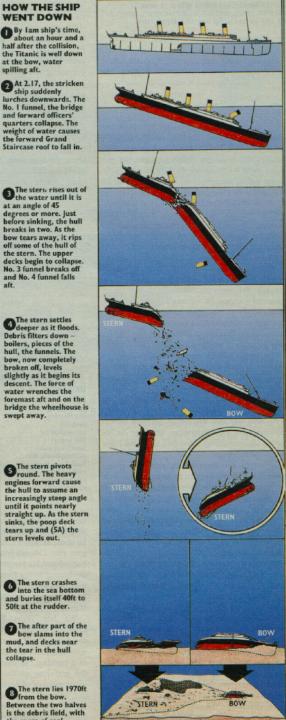
When a ship it sinks it leaves a path of debris (objects from within the ship or objects breaking off). Depending how deep the vessel sinks this debris can be scattered over a large distance. On a shorter descent, the debris falls more or less vertically. However, as the Titanic sank 21/2 miles a huge debris field was expected.
A new search strategy was formed. This time they would first look for the debris field rather than the Titanic herself.
The logbook of the Californian enabled Ballard and his crew to estimate the speed and direction of drift of the lifeboats. The Californian was between five to ten miles away from the Titanic at the time of the disaster and reported in its log that they had experienced drift. Also Ballard knew that the Titanic had to be north of where the lifeboats were found.
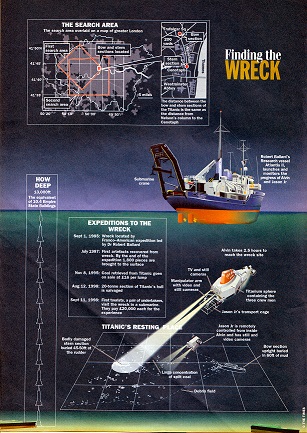
On August 24 1985 Ballard returned to the vacinity of the Titanic. He had 12 days to locate the wreck. Argo was launched the next day but encountered technical problems. After another six days, the crew was fed up with the monotiny of observing sand, mud and the bottomless ocean.
But on the 1st September 1985 a strange appeared on the Video monitors. A BOILER!!!
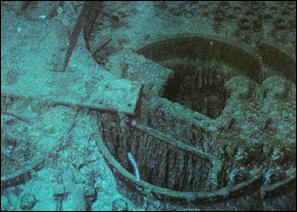
The RMS Titanic had to be near.
New hopes were realised. Argo was launched to scan the search area for the Titanic. Eventually at an altitude of 160 feet above the bed, Argo passed over the main hull of the ship. They could see that the funnel had gone (the one which Lightoller recalled saved his life when it tore out of its fixtures moments before the ship went down).
Their first look at the Titanic lasted six minutes: she was upright and a large section of her hull was in tact. She laid 13,000 feet below the surface.
Following much the cheering and clapping, reverential silence overcame the crew of the Knorr. It was almost 2 a.m. and very close to the time when the Titanic actually sank. Argo was used to photograph the wreck during the many passages made over her.
Soon news that the Titanic had been found had reached the corners of the world. Once more the RMS Titanic was in the minds of millions of people.
EXPLORATION OF THE TITANIC
Day 1
On July 13th 1986 another Ballard expedition was underway to explore the Titanic in more detail.
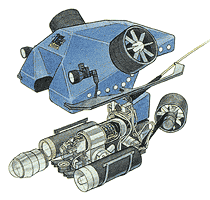
Jason Junior (JJ) would be used to video the Titanic. JJ would be operated on a long cable attached to Alvin which contained three crew who would steer JJ.
Day 2
After a short lived dive due to battery failure, a second dive proved highly successful.

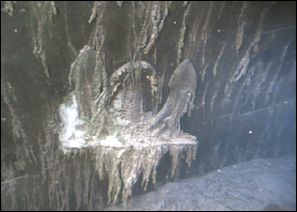
Apparently from nowhere, the razor sharp bow of the Titanic came into view. Both anchors were still in place. It appeared that the bow was buried more than 60 foot in the mud.
Ballard described the decaying metal as "frozen rivers of rust covering the ships' side and spread out over the ocean floor."
As Alvin moved across the forward deck, the giant bollards and capstans were clearly visible although the wires and ropes once connected to them were gone. The wooden floor had been eaten away.
The expedition continued to the severed section of the intact bow section. A sudden strong current stopped the trip and Alvin was forced to head to the surface.
Day 3
JJ traversed the Grand Staircase, which at one time had been covered by a glass dome. Whatever JJ saw, Alvin's crew saw too. A Chandelier had survived the journey to the bottom of the sea. JJ's maiden voyage was a total success.
Day 4
The team visited Captain Smith's cabin to find its outer walls collapsed to a heap on the deck. Next, JJ explored the Gym where pieces of equipment could be seen in amongst the rubble. Metal frames from the electric camel were also intact.
Day 5

The debris field spans nearly 2000 feet between the two sections of the Titanic. The debris includes lumps of coal, wrought-iron deck benches, baths, crockery and other bric-a-brac.
 
Another boiler was found with an iron cup sitting peacefully on top of it. A safe was found on the ocean floor proudly showing off its brass handle. Ballard tried to open the safe but the door would not open to reveal its contents.
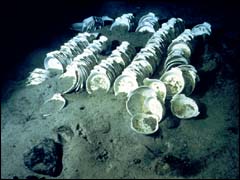
Day 6
It was clear from the debris field that the torn-off stern section had been badly damaged during its journey to the bottom and now lay 1,970 feet from the bow section.
Ballard's next plan lead Alvin along the bottom of the ocean bed directly behind the stern section and sent JJ to examine the hull. He found that the stern section was also buried deep beneath the mud, probably to a depth of 45 feet. Both middle and starboard side propellers were under the mud.
Before leaving the wreck, Ballard placed a memorial plaque on the stern in memory of those who lost their lives on that fateful night.

|
